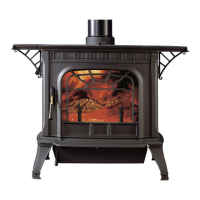~
-
~
~
~
I
Always~eargloveswhen
OPERATION
operating the stove.
The Combustion Process
Combustion in the Harman Oakwood is precisely
controlled and is divided into two parts.
During a wood fire, primary combustion air en-
ters at the bottom front
of
the stove and travels up chan-
nels at either side
of
the front door pre-heating it.
It
then
enters the manifold located above the front door where
it
is released into the primary firebox as a sheet
of
air flow-
ing between the glass and the wood to support primary
combustion
in
the firebox.
Secondary combustion air enters the stove at the
bottom
rear
of
the
stove
and
is
delivered
into
the
"Firedome" secondary combustion package, and the rear
bricks to provide a critical additional source
of
oxygen at
several locations within the combustion package to sup-
port secondary combustion necessary to achieve and sus-
tain clean burning.
During combustion, the burning
of
wood proceeds
through several stages. The initial
or
evaporation stage is
where the moisture
in
the wood
is
driven
off
in
the form
of
steam. A second stage where the volatile gases con-
tained in the wood are released and burned. This repre-
sents most
of
the wood's heating capacity. The final stage
is the charcoal stage where the charcoal
bums
the re-
maining heat content in the wood fuel. Ash remains after
the burning is complete. Within the primary firebox two
or
more
of
these stages
of
combustion are occuring at
once.
8 Oakwood
Wood
Stove
Two important controls - the damper bypass handle
and the air control lever regulate the operation and output
of
the stove.
To
open the top or front loading door, you must
open the damper bypass,
or
smoke will come
in
the room.
In
this mode
of
operation the combustion gases go di-
rectly from the main combustion chamber to the flue col-
lar and exit into the chimney.
NOTE: The bypass damper must be open for
smokeless loading.
Open the bypass damper
by
turn-
ing the handle clockwise while facing handle.
Damper Open
Damper
Closed
Top Load Door
Open

